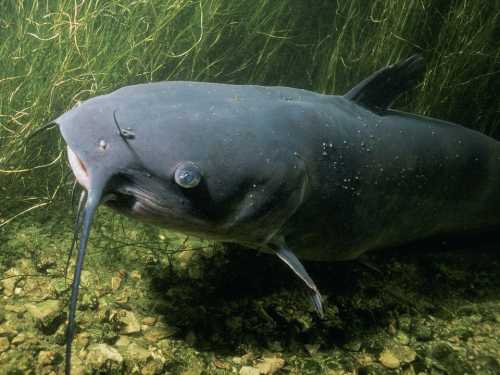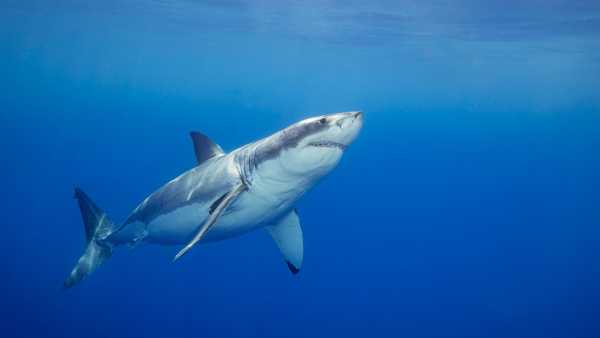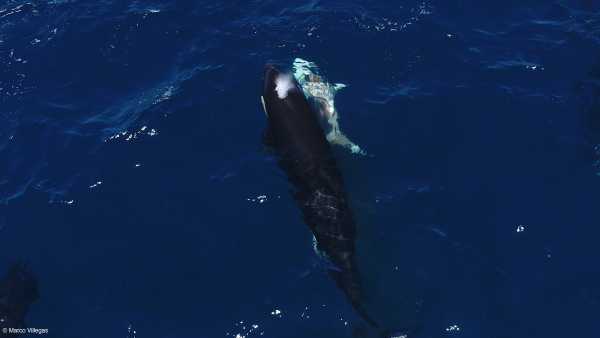
The European catfish is not only the largest freshwater fish in Europe, capable of reaching incredible sizes and weights, but also a key predator in its ecosystems. Its potential for longevity and growth is impressive, and it is intensive fishing, as well as changes in the natural environment, that prevent many individuals from reaching their full size.
This creates a paradox: we admire their size, but we ourselves limit their development. Perhaps our admiration for their “legendary coolness” and “feline” nature reflects our subconscious respect for these ancient and mysterious water dwellers, who, despite our dominance, retain their wildness and power.
Catfish are a kind of “water seals”, and in English-speaking countries they are called “Catfish” – catfish. This name is suggested by the presence of long sensitive whiskers, resembling cat whiskers. Also, unlike most fish, European catfish (like many other catfish species) do not have scales at all. Their body is covered with smooth, slippery skin, which helps them easily slide through dense thickets, silt and underwater obstacles. This feature makes their skin sensitive and allows them to better feel changes in water pressure and vibrations, which is important for a nocturnal predator.
These “elegant fish whiskers”, or scientifically – barabuli antennae, are their unique sensory system. European catfish usually have six of them: two long ones on the upper jaw and four shorter ones on the lower. They are not just organs of touch, but also chemical sensors. Numerous taste receptors are located on their surface, allowing catfish to “sniff” and “taste” water, detecting the smallest concentrations of organic substances. This is especially valuable in murky water or at night, when vision becomes almost useless. The ability to sense weak water movements helps them detect prey, even if it is stationary – thanks to the lateral line system (a series of channels with mechanoreceptors-neuromasts along the body), which complements the function of the antennae. This really makes them extremely effective predators, relying not on vision, but on other, more subtle senses.
This “sedentary” lifestyle is a strategic adaptation for catfish. Instead of energy-consuming pursuit of prey, they prefer to conserve energy by resting in shelters – deep holes, under snags or overhanging banks. This is not laziness, but an efficient approach of a predator waiting for the perfect moment to attack. Their cleverness is manifested not only in patient waiting, but also in the ability to adapt tactics to the conditions. For example, there are known cases when catfish, especially large individuals, “patrol” certain areas or even use the so-called “team” fishing, driving prey into a corner, which indicates the presence of certain cognitive abilities.
The European catfish is a classic opportunistic predator. This strategy allows catfish to survive and grow to gigantic sizes in a wide variety of environments, as they are not restricted to a single prey species. Dietary flexibility is key to their success as a top predator. They can effectively utilize any available resources, making them resilient to fluctuations in the populations of individual prey species and allowing them to survive in changing environments.
This pronounced ontogenetic shift in diet—from small invertebrates to large vertebrates—reflects their incredible growth and adaptability. Juveniles, feeding on small organisms, effectively utilize the initial links of the food chain. As they grow, they switch to fish, becoming a real “thunderstorm of the reservoir,” controlling populations of other species. And the “titans,” which can reach weights of hundreds of kilograms, expand their hunting arsenal to waterfowl and even small mammals that come close to the water. This ability to hunt on the surface, where they jump out of the water, grabbing prey, is a testament to their resourcefulness. Their constant attachment to carrion emphasizes their important role as sanitation workers of reservoirs, preventing the spread of disease and maintaining ecological balance.
Stories of catfish attacks on humans that “regularly” appear in the news create a sense of danger around these fish. These cases, although rare and often not confirmed by fatal consequences, feed popular legends and myths. Such reports usually concern large individuals that may confuse a swimmer or a person standing in the water with potential prey, especially in murky water or during spawning, when catfish become more aggressive and territorial. It is important to understand that these are incidents rather than targeted hunting.
Despite the prevalence of rumors about man-eating catfish that “give fishermen nightmares”, there are currently no confirmed cases of human deaths from attacks by European catfish. This indicates that the real danger is greatly exaggerated by folklore and fear of the unknown. The enormous size of catfish can cause panic, but their jaws and teeth are not adapted to hold large, resisting prey, such as sharks or crocodiles. They are more likely to “suck” their prey. Therefore, although caution is not necessary, it is unfair to turn catfish into a killer monster.
The fact that the European catfish is the largest freshwater fish in Europe is already enough for legends. Mentions of individuals weighing 300 kilograms and over 3 meters long 100-200 years ago are not a myth. These colossal sizes were possible due to the abundance of water resources and less fishing pressure. Modern aquatic ecosystems, unfortunately, rarely boast such individuals. Intensive fishing, especially trophy fishing, has significantly reduced the average size of catfish and practically eliminated record holders from the population.
This has ecological implications, as large individuals play a key role in maintaining a healthy gene pool and regulating populations at the bottom of the food chain. However, even now, encountering a catfish over 100 kilograms is a real event, reminding us of their potential.
The secret to their enormous size lies in a combination of two factors: indeterminate growth and impressive longevity. Indeterminate growth means that the catfish continues to grow throughout its life, rather than stopping at a certain size, like mammals. Provide it with enough food and a favorable environment, and it will grow. An 80-year-old catfish is not just an old fish, but a true “patriarch” of the ecosystem. Their presence in a reservoir indicates the health and stability of the ecosystem.
Theoretically, catfish can live up to 100 years, but, unfortunately, in practice, it is almost impossible to meet such long-livers. The reasons for this are multifaceted. First, large catfish require significant, prey-rich habitats, which modern rivers and lakes often can no longer provide due to pollution, flow regulation and a general reduction in the food base. Second, their impressive longevity and size, which are an advantage in the wild, become their curse in encounters with humans. “Hunting giants” for many fishermen is a “matter of honor”, which leads to the removal of the most valuable individuals from the population that have reached reproductive age and maximum size. This not only limits the age of the catfish, but also negatively affects the overall stability and diversity of the species.





